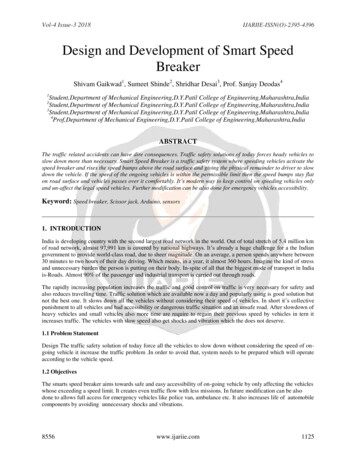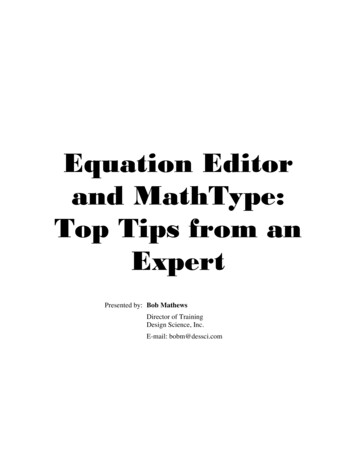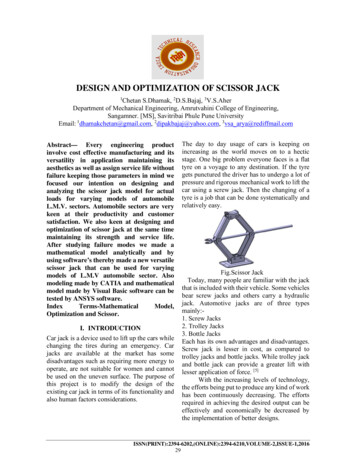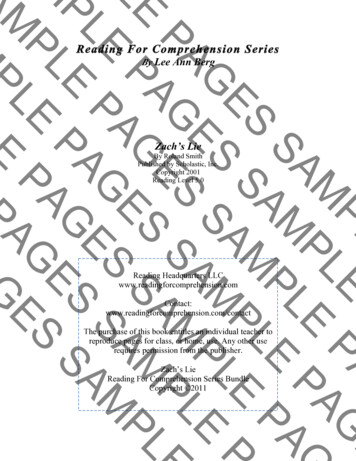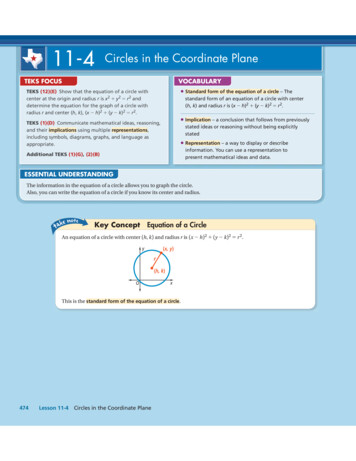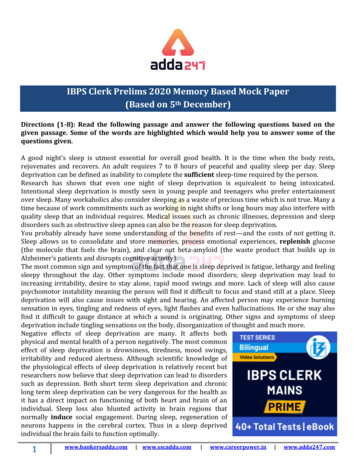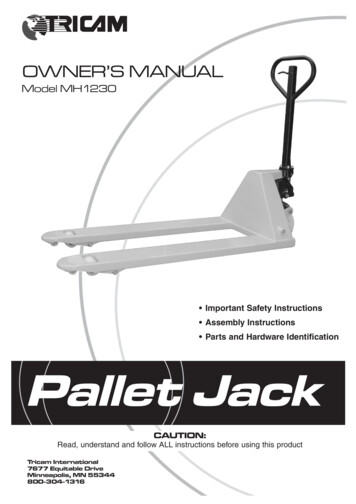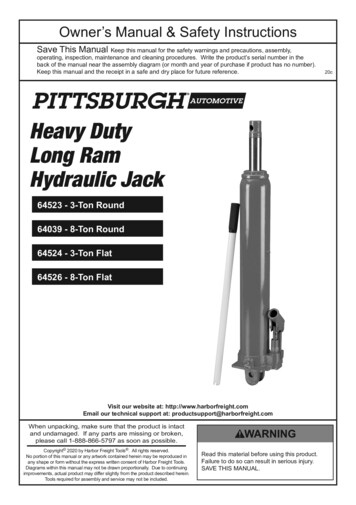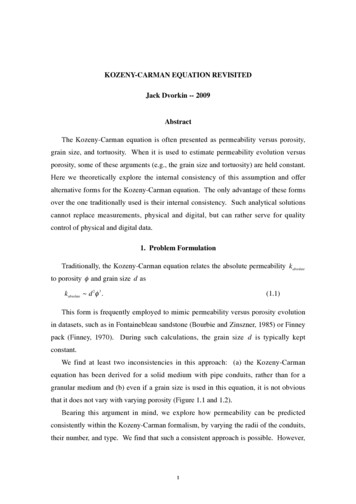
Transcription
KOZENY-CARMAN EQUATION REVISITEDJack Dvorkin -- 2009AbstractThe Kozeny-Carman equation is often presented as permeability versus porosity,grain size, and tortuosity. When it is used to estimate permeability evolution versusporosity, some of these arguments (e.g., the grain size and tortuosity) are held constant.Here we theoretically explore the internal consistency of this assumption and offeralternative forms for the Kozeny-Carman equation. The only advantage of these formsover the one traditionally used is their internal consistency. Such analytical solutionscannot replace measurements, physical and digital, but can rather serve for qualitycontrol of physical and digital data.1. Problem FormulationTraditionally, the Kozeny-Carman equation relates the absolute permeability kabsoluteto porosity φ and grain size d askabsolute d 2φ 3 . (1.1) This form is frequentlyemployed to mimic permeability versus porosity evolution in datasets, such as in Fontainebleau sandstone (Bourbie and Zinszner, 1985) or Finneypack (Finney, 1970). During such calculations, the grain size d is typically keptconstant.We find at least two inconsistencies in this approach: (a) the Kozeny-Carman equation has been derived for a solid medium with pipe conduits, rather than for agranular medium and (b) even if a grain size is used in this equation, it is not obviousthat it does not vary with varying porosity (Figure 1.1 and 1.2).Bearing this argument in mind, we explore how permeability can be predictedconsistently within the Kozeny-Carman formalism, by varying the radii of the conduits,their number, and type. We find that such a consistent approach is possible. However,1
it requires additional assumptions, specifically, regarding tortuosity evolution duringporosity reduction.In the end we arrive at alternative forms for the Kozeny-Carman equation, whichstill should not be used to predict permeability, but instead to quality-controls physicaland digital experimental data.0.2500.1670.1090.072Figure 1.1. Cross-sections of four Fontainebleau sandstone samples with decreasing porosity (postedon top of each image). The scale bar in each image is 0.5 mm. We argue that it is not obvious whichparameters (grain size, conduit size, or the number of conduits) change during porosity reduction.2
Figure 1.2. Cross-sections of a Finney pack for uniformly increasing radius of each sphere (from1.00 to 1.45 mm with 0.05 mm increment, left to right and top to bottom) and respectively decreasingporosity (posted on top of each image). As in the images in Figure 1.1, it is not immediately obviouswhich parameters (grain size, conduit size, or the number of conduits) change during porosityreduction.3
2. Definition of Absolute PermeabilityThe definition of absolute permeability kabsolute of porous rock comes from Darcy’sequation (e.g., Mavko et al., 1998)Q k absoluteA dP,µ dx (2.1)where Q is the volume flux through the sample (in, e.g., m3/s); A is the cross-sectionalarea of the sample (in, e.g., m2); µ is the dynamic viscosity of the fluid (in, e.g., Pa s with 1 cPs 10-3 Pa s); and dP /dx is the pressure drop across the sample divided by the length of the sample (in, e.g., Pa/m). 3. Flow Through a Circular PipeThe equation for laminar viscous flow in a pipe of radius b is 2 u 1 u 1 dP , r 2 r r µ dx(3.1) where u is the velocity of the fluid in the axial ( x ) direction; µ is the dynamic viscosityof the fluid; dP /dx is the pressure gradient in the axial direction; and r and x are the radial and axial coordinates, respectively. A general solution of Equation (3.1) is u A B r 2 C ln r, (3.2)where A , B , and C are constants. It follows from Equation (3.2) that uC 2 uC 2Cr , 2C 2 .2 rr rr (3.3)By substituting the expressions from Equation (3.3) into Equation (3.1) we find that 2 B C C 1 dP 2 B 2 ,2rrµ dy(3.4)which means that 1 dPB .4 µ dx(3.5)4
To avoid singularity at r 0 we need to assume that in Equation (3.2) C 0.Next, we will employ the no-slip condition u 0 at r b .1 dP 2 1 dP 2u A B r 2 A r A b 0,4 µ dx4 µ dx (3.6)which means 1 dP 2A b4 µ dx(3.7)and u 1 dP 2r2b (1 2 ).4 µ dxb(3.8)The total volume flux through the pipe is q πb 4 ΔP,8µ l(3.9)where l is the length of the pipe, ΔP is the pressure head along the length of the pipe,and the pressure gradient dP /dx is replaced with ΔP /l . 4. Absolute Permeability – Round Pipe Assume that a pore space is made of N identical parallel round pipes embedded in asolid block at an angle α to its horizontal face (Figure 4.1). The horizontal pressurehead across the block is ΔP . The length of each pipe inside the block is l L /sin α Lτ ,(4.1) horizontal length of the block and, by definition, τ sin 1 α is thewhere L is thetortuosity. Using Equations (3.9) and (4.1), we obtain the total flux through N pipes as Q Nq Nπb 4 ΔPπb 4 dPb 2 dP N Nπb 2τ,8µ Lτ8µτ dx8µτ 2 dx where ΔP /Lτ is the pressure gradient across the pipe.The porosity of the block due to the pipes is 5(4.2)
φ Nπb 2 l Nπb 2τ ,ALA(4.3)where A is the cross-sectional area of the block, same as used in Equation (2.1). Figure 4.1. Solid block with a pipe used for Kozeny-Carman derivations (left). Notations areexplained in the text. To the right, we show a cross-section of an open pipe and that of the same pipewith a concentric solid kernel.By combining Equations (4.2) and (4.3), we obtainQ φb 2 A dP,8τ 2 µ dx(4.4)which means (using the definition of absolute permeability) that kabsolute b 2φ.8τ 2(4.5)Let us next introduce another characteristic of the pore space, the specific surface area s, which, by definition, is the ratio of the pore surface area to the total volume ofthe block. For the block permeated by pipes, s N2πbl N2πbτ Nπb 2τ 2 2φ .ALAA b b(4.6)and, therefore, b 2φ /s and kabsolute 1 φ3.2 s2τ 2(4.7)Finally, let us combine Equations (2.1) and (4.2) to obtain kabsoluteN πb 4 .Aτ 8(4.8)6
5. Absolute Permeability -- Concentric PipeConsider fluid flow through a round pipe of radius b with a concentric solid kernelof radius a inside (Figure 4.1). Equations (3.1) and (3.2) are still valid for the flowinside the annular gap formed by the pipe and kernel. The solution for velocity u inside the annular gap is obtained from Equation (3.2) and using the no-slip ( u 0) boundary conditions at r b and r a : 1 dP 2r2a 2 ln(b /r)u b [(1 2 ) (1 2 )].4 µ dxbb ln(b /a) (5.1)A comparison of the radial velocity field according to Equation (5.1) and (3.8) is displayed in Figure 5.1.Figure 5.1. Normalized velocity of fluid versus the normalized radius of a circular pipe for (a) flowin a circular pipe without a kernel and (b) annular floe in a pipe with a kernel for the radius of thekernel 0.1 of that of the pipe.By integrating the right-hand part of this equation times 2πr from a to b and withrespect to r we obtain the flux through the annular gap: π ΔP 4a2a2a21q b (1 2 )[1 2 (1 2 )]. 8µ lbbb ln(a /b) (5.2)Let us remember that for a pipe without a kernel, q πb 4 ΔP.8µ l(5.3)We can arrive at this expression from Equation (5.2) if a 0 and ln a . 7
Also, if a b , the infinity in the denominator of the third term in the squarebrackets in Equation (5.2) has the same order as that in the numerator, and q 0 .In Figure 5.2 we display the ratio ξ of the flux computed according to Equation (5.2) to that according to Equation (5.3): 222aaa1ξ (1 2 )[1 2 (1 2 )],(5.4)bbb ln(a /b)which behaves predictably. Figure 5.2. Ratio of annular flux to that through a round pipe versus the normalized radius of akernel.The total flux through N pipes with a kernel isπ ΔP 4a2a2a21Q Nq Nb (1 2 )[1 2 (1 2 )].8µ Lτbbb ln(a /b) (5.5)Hence the absolute permeability is kabsolute N πb 4a2a2a21(1 2 )[1 2 (1 2 )].Aτ 8bbb ln(a /b)(5.6)The porosity of this block is now Nπ (b 2 a 2 )l Nπ (b 2 a 2 )τφ .ALA(5.7)The specific surface area is 8
s N2π (b a)l N2π (b a)τ Nπ (b 2 a 2 )τ 22φ .ALAAb a b a(5.8)As a result, kabsolute φ 2a2a21b[1 (1 )].2228τbb ln(a /b)(5.9)6. Permeability versus Porosity Within the above formalism, one may envision at least three porosity variationscenarios: (a) the number of the pipes N varies, (b) the number N remains constant,but the radius of the pipes b varies, and (c) the number N remains constant and so doesthe radius of the pipes b , but concentric kernels of radius a grow inside the pipes (Figure 6.1). Original Block Porosity Reduces withthe Number of PipesPorosity Reduceswith the Radius of PipesPorosity Reduces with theRadius of KernelsFigure 6.1. Porosity reduction from that of the original block (left) by the reduction of the number ofthe pipes (middle), the radius of a pipe (third to the right), and radius of the kernels.Consider a solid block with a square cross-section with a 10-3 m side and theresulting cross-sectional area A 10-6 m2. It is penetrated by N 50 identical roundpipes with radius b 2.83·10-5 m. Also assume τ 2.5. The resulting porosity is φ Nπb 2τ / A 0.30. The resulting permeability, according to Equation (4.8), is kabsolute -524.772·10 m 4772 mD. Next, we alter the original block (left image in Figure 6.1) according to the proposed three porosity reduction scenarios. The results are shown in Figure 6.2, where we alsodisplay the classical Fontainebleau sandstone data as well as data for North Sea sand(Troll field). This figure also explains our choice of the solid block and pipe parametersearlier in this section – the numbers selected helped match the porosity and permeability9
of the original block to those of the highest-porosity Fontainebleau sample.Figure 6.2. Permeability versus porosity according to scenarios a, b, and c. Open symbols are formeasured permeability in Fontainebleau sandstone. Filled symbols are for measured permeability insand samples from Troll field offshore Norway.Figure 6.2 also indicates that none of the proposed simple models reproduces thetrends present in real data.7. Third Dimension and TortuosityModeling rock as a block with fixed cross-section, clearly does not producepermeability results that match laboratory data. Let us hypothesize that the effect of thethird dimension can be modeled by varying the tortuosity τ . Specifically, within theKozeny-Carman formalism, let us assume that τ varies with porosity φ .Consider two candidate equations for this dependence: τ φ 1.2, (7.1)derived from laboratory contaminant diffusion experiments by Boving and Grathwohl (2001) andτ (1 φ 1 ) /2,(7.2)theoretically derived by Berryman (1981). 10
At φ 0.3, these two equations give τ 4.24 and 2.17, respectively.Let us next repeat out calculations of permeability for the three porosity evolution scenarios, but this time with the tortuosity varying versus porosity. Also, to keep the scale consistent, we will scale Equations (7.1) and (7.2) to yield τ 2.5 at φ 0.3 asfollowsτ 0.590φ 1.2 (7.3)and τ 0.576(1 φ 1 ).(7.4)The results shown in Figure 7.1 indicate that both the above equations produce similar results. Permeability calculated for porosity reduction scenario with contractingpipe size matches the Fontainebleau data in the medium-to-high porosity range but failsfor low porosity.Figure 7.1. Permeability versus porosity according to scenarios a, b, and c with varying tortuosity.Left, according to Equation (7.3) and right, according to Equation (7.4).Our final attempt to match the Fontainebleau data is to assume that the tortuositybecomes infinity at some small percolation porosity φ p (following Mavko and Nur,1997). The resulting equations for tortuosity becomeτ 0.590(φ φ p ) 1.2 11(7.5)
andτ 0.576[1 (φ φ p ) 1 ].(7.6)The resulting permeability curves for the case of shrinking pipes and φ p 0.025 are displayed in Figure 7.2. This final match appears to be satisfactory. Figure 7.2. Permeability versus porosity for shrinking pipes and for tortuosity given by Equation(7.4) – top curve, Equation (7.5) – middle curve, and Equation (7.6) – bottom curve.The resulting forms of the Kozeny-Carman equation obtained by combiningEquations (4.5) and (4.7) with Equation (7.6) are, respectively,kabsolute 0.357b 2φ[1 (φ φ p ) 1 ]2(7.7)kabsolute 1.507s 2φ3.[1 (φ φ p ) 1 ]2(7.8)and Some other reported relations between τ and φ are: τ 0.67φ 1 ,(7.9) theoretically derived based on the assumptionof fractal pore geometry (Pape et al., 1998) and12
τ 1.8561 0.715φ, 0.1 φ 0.5;τ 2.1445 1.126φ, 0.3 φ 0.5;τ 2.1472 5.244 φ, 0.6 φ 1.0;(7.10)derived from laboratory fluid flow experiments on textiles, kaolinite, and soil by Salem and Chilingarian (2000). Tortuosity according to Equations (7.1), (7.2), (7.9), and(7.10) is plotted versus porosity in Figure 7.3). The large difference between individualcurves is likely due to the materials and models these curves were derived for.Figure 7.3. Tortuosity versus porosity according to equations in the text. Equation numbers areposted next to the curves.8. Kozeny-Carman Equation with Grain SizeThe Kozeny-Carman formalism operates with pipe conduits. However, its commoninterpretation for clastic sediment attempts to operate with the grain size. Such atransformation is possible if one considers permeability Equation (4.7)kabsolute 1 φ32 s2τ 2(8.1)and relates the specific surface area s to the grain size. This is possible if we consider a dense random pack of M identical spherical grainswith radius r and porosity φ 0 . The volume of each individual grain is (4 /3)πr 3 and the total volume of the pack is hence (4 /3)Mπr 3 /(1 φ 0 ) . The surface area of the pore 13
space is 4 Mπr 2 . Therefore, for this specific case,(8.2)s 3(1 φ 0 ) /r 6(1 φ 0 ) /d, where d 2 r .Note that this equation is only valid for a sphere pack with porosity φ 0 0.36. If we assume that the same equation applies to the entire porosity range, which is clearly invalid since s should be generally decreasing with decreasing porosity, we obtain form Equations (8.1) and (8.2)r2φ3d2φ3 kabsolute ,18 (1 φ ) 2 τ 2 72 (1 φ ) 2 τ 2(8.3)where d 2 r .We can also modify this last equation by introducing a percolation porosity φ p (Mavko and Nur, 1997) as kabsolute3d 2 (φ φ p ) ,72 (1 φ φ p ) 2 τ 2 (8.4)The corresponding curve for φ p 0.025, d 0.25 mm 0.00025 m, and constant tortuosity τ 0.25 is plotted in Figure 8.1. Figure 8.1. Black curve: permeability versus porosity for shrinking pipes with the tortuosity givenby Equation (7.6). Red curve: permeability versus porosity according to Equation (8.4) withparameters described in the text.14
9. ConclusionConsistency is possible in deriving and applying Kozeny-Carman equation forpermeability as a function of porosity. Any such derivation inherently requires suchidealized and, generally, nonexistent in real rock parameters as grain size, pore size, andtortuosity. Yet, the Kozeny-Carman equation can be made to mimic some experimentaltrends and, therefore, serve as a quality-control tool for physical and digitalexperimental results.ReferencesBerryman, J.G., 1981, Elastic wave propagation in fluid-saturated porous media,Journal of Acoustical Society of America, 69, 416-424.Bourbie, T., and Zinszner, B., 1985, Hydraulic and acoustic properties as a function ofporosity in Fontainebleau Sandstone, Journal of Geophysical Research, 90, 11,52411,532.Boving, T.B., and Grathwohl, P., 2001, Tracer diffusion coefficients in sedimentaryrocks: correlation to porosity and hydraulic conductivity, Journal of ContaminantHydrology, 53, 85-100.Finney, J., 1970, Random packing and the structure of simple liquids (The geometry ofrandom close packing), Proceedings of the Royal Society, 319A, 479.Mavko, G., and Nur, A., 1997, The effect of a percolation threshold in the KozenyCarman relation, Geophysics, 62, 1480-1482.Pape, H., Clauser, C., and Iffland, J., 1998, Permeability prediction for reservoirsandstones and basement rocks based on fractal pore space geometry, SEGExpanded Abstracts, SEG 1998 Meeting.Salem, H., and Chilingarian, G.V., 2000, Influence of porosity and direction of flow ontortuosity in unconsolidated porous media, Energy Sources, 22, 207-213.15
Appendix: Specific Surface Area of the Finney Pack with Expanding SpheresWe select a cubic subset of the Finney pack and gradually and uniformly expand theradius of each sphere from 1 to 1.5 mm. The evolution of the porosity of these packsversus the radius of a sphere is shown in Figure A.1.Figure A.1. Left – porosity of a Finney pack decreasing with the increasing radius of each sphere.Middle – the specific surface area decreasing with the increasing radius of each sphere. Right – thespecific surface area increasing with increasing porosity (black). The red curve is computed fromEquation (A.1) with fixed sphere radius 1 mm. The blue curve is also computed from Equation (A.1)but with respectively increasing sphere radius.In the same figure we display the calculated specific surface area versus the radiusand the specific surface area versus the porosity. In the latter frame, we also display atheoretical curve according to equation(A.1)s 3(1 φ ) /rfor varying porosity and fixed radius r 1 and for varying porosity and varying radius. Neither of these two theoretical curves even qualitatively matches the computed specificsurface area. 16
Traditionally, the Kozeny-Carman equation relates the absolute permeability k absolute to porosity φ and grain size d as k absolute d2φ3. (1.1) This form is frequently employed to mimic permeability versus porosity evolution in datasets, such as in Fontainebleau sandstone (Bourbie and Zinszner, 1985) or Finney pack (Finney .
